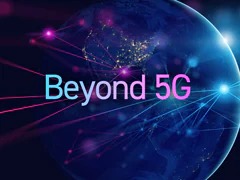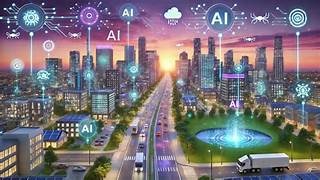
6G visions: what’s next beyond 5G and 5G-Advanced (terahertz, holographic radios etc.).
Exploring the Future of Wireless Communication: 6G promises to revolutionize connectivity beyond 5G and 5G-Advanced, leveraging terahertz frequencies, holographic radios, AI-native networks, and non-terrestrial systems. With ultra-high speeds, near-zero latency, immersive XR experiences, and integrated sensing, 6G envisions a fully intelligent, sustainable, and globally connected world, transforming industries, healthcare, smart cities, and human-computer interaction.
✨ Raghav Jain

Introduction
The global telecommunications landscape has been transformed by the rollout of 5G networks, which promised faster speeds, ultra-low latency, and unprecedented connectivity for smart cities, autonomous vehicles, and the Internet of Things (IoT). However, as 5G continues to mature, the industry is already looking beyond—towards 5G-Advanced and the ambitious horizon of 6G networks.
6G, expected to emerge around 2030, aims to push the boundaries of wireless communication with terahertz frequencies, holographic radios, AI-native networks, ultra-low energy devices, and immersive extended reality (XR) experiences. While 5G focused on enhancing broadband and machine-type communication, 6G envisions a truly intelligent, fully connected digital-physical world, blurring the lines between human senses and machine interfaces.
This article provides a deep dive into the visions, technologies, and challenges of 6G beyond 5G and 5G-Advanced, exploring what the future of wireless connectivity might look like.
Evolution Beyond 5G: The Role of 5G-Advanced
Before 6G becomes a reality, 5G-Advanced—a mid-term evolution of 5G—will serve as the stepping stone. Standardized by 3GPP Release 18 and beyond, 5G-Advanced is expected to launch commercially around 2025–2026.
Key Features of 5G-Advanced:
- Enhanced AI/ML Integration – Networks will be increasingly autonomous, self-optimizing, and predictive.
- Improved Spectrum Efficiency – Use of unlicensed and shared spectrum with dynamic spectrum sharing (DSS).
- Extended Reality (XR) Optimization – Support for AR/VR/XR applications requiring sub-10 ms latency.
- Massive IoT Expansion – Connecting billions of low-power sensors, enabling smarter cities and industries.
- Green Networks – Focus on reducing network energy consumption through intelligent resource allocation.
Thus, 5G-Advanced provides a bridge—building intelligence and efficiency into networks while paving the way for the radical shifts of 6G.
What is 6G?
6G (Sixth Generation Wireless Communication) is envisioned as the successor to 5G, expected to be standardized in the early 2030s. Unlike 5G, which centered around higher data rates and reduced latency, 6G aims for a deep fusion of physical, digital, and biological worlds.
6G Ambitions:
- Peak Data Rates: Up to 1 Tbps (compared to 10 Gbps in 5G).
- Latency: As low as 0.1 ms, virtually real-time communication.
- Frequency Spectrum: Expansion into terahertz (THz) bands (100 GHz to 3 THz).
- Ubiquitous Connectivity: Coverage across Earth, oceans, and even space-based communications via non-terrestrial networks (NTNs).
- AI-Native Architecture: Networks driven by AI and machine learning, not just AI-assisted.
- Sustainable and Green: Ultra-low power consumption and carbon-neutral infrastructures.
Core Technologies Driving 6G
1. Terahertz (THz) Communication
- Operates in the 0.1–10 THz range, enabling ultra-high data rates (>1 Tbps).
- Allows uncompressed 8K/16K streaming, holographic calls, and real-time digital twins.
- Challenges: High propagation loss, atmospheric absorption, and need for advanced materials (like graphene-based antennas).
2. Holographic Radios
- Move beyond traditional antennas to holographic beamforming surfaces, capable of generating and manipulating radio waves with extreme precision.
- Supports massive MIMO (multiple-input, multiple-output) for better spectral efficiency.
- Enables holographic communications—true 3D telepresence and lifelike remote interactions.
3. AI-Native Networks
- AI will not just assist but drive network management, optimization, and security.
- Self-healing, predictive, and adaptive networks will become standard.
- Example: AI can dynamically allocate spectrum in milliseconds based on traffic surges.
4. Integrated Sensing and Communication (ISAC)
- 6G networks will double as radars and sensors, mapping environments in real-time.
- Benefits autonomous vehicles, drones, and smart factories with centimeter-level positioning accuracy.
5. Quantum Communication and Security
- Use of quantum key distribution (QKD) for unhackable communication.
- Ensures post-quantum cryptography resilience as quantum computers advance.
6. Non-Terrestrial Networks (NTN)
- Integration of satellites, drones, and high-altitude platforms with terrestrial infrastructure.
- Goal: Global 6G coverage, including oceans, rural regions, and disaster-hit areas.
7. Brain-Computer Interfaces (BCIs) and Haptic Internet
- 6G could enable direct neural interfaces, allowing thoughts to control devices.
- Tactile internet: Users experience touch, texture, and force feedback remotely in real-time.
Potential Applications of 6G
- Immersive Extended Reality (XR)
- Full sensory AR/VR/MR environments for gaming, education, and telemedicine.
- Real-time holographic meetings replacing traditional video calls.
- Digital Twins
- Entire cities, factories, or human organs can be replicated in real-time for monitoring and prediction.
- Autonomous Systems
- Fleets of drones, self-driving cars, and robots communicating with near-zero latency.
- Healthcare Revolution
- Remote robotic surgeries with tactile feedback.
- AI-driven health monitoring with implanted nano-sensors.
- Smart Cities and Infrastructure
- Real-time management of traffic, energy, and security using billions of connected sensors.
- Global Internet Coverage
- Seamless connectivity via satellite-6G integration, bridging the digital divide.
Challenges and Limitations of 6G
- Spectrum Challenges
- Terahertz frequencies face severe propagation loss and require new antenna technologies.
- Energy Consumption
- Ultra-fast, high-capacity networks must remain sustainable and energy-efficient.
- Infrastructure Costs
- Massive investments needed for base stations, satellites, and AI-driven core networks.
- Standardization and Policy
- Global collaboration essential; lack of alignment may delay rollout.
- Security Risks
- While quantum cryptography helps, new attack surfaces (AI manipulation, BCI hacking) must be addressed.
- Digital Divide
- Risk that advanced 6G benefits may be limited to wealthy nations if costs remain prohibitive.
The Roadmap Towards 6G
- 2023–2025: 5G-Advanced rollout, research in terahertz and holographic radios.
- 2026–2028: Early 6G testbeds, pilot projects in smart cities and industrial IoT.
- 2028–2030: Standardization (ITU, 3GPP), first pre-commercial 6G trials.
- 2030+: Commercial deployment of 6G with global adoption starting mid-2030s.
The evolution of wireless communication has always been about pushing boundaries, from 1G analog calls to 4G LTE that brought mobile internet, and now 5G, which has transformed industries with faster speeds, ultra-low latency, and mass IoT integration, yet even as 5G matures the telecom world is already looking ahead to 5G-Advanced and ultimately 6G, which is expected to arrive by 2030 as the next revolutionary step; 5G-Advanced, due around 2025–2026 through 3GPP Release 18, will act as a bridge by integrating artificial intelligence more deeply into networks, improving spectrum efficiency, enabling extended reality with ultra-low latency, supporting massive IoT, and focusing on greener, more energy-efficient networks, but 6G goes far beyond these incremental improvements with a vision to merge physical, digital, and biological worlds in real-time through terahertz communications, holographic radios, and AI-native architectures; 6G ambitions include peak data rates of up to 1 terabit per second, end-to-end latency as low as 0.1 milliseconds, ultra-dense connectivity, and seamless coverage via non-terrestrial networks that integrate satellites, drones, and high-altitude platforms with ground infrastructure, while also embedding sustainability at the core by drastically reducing energy consumption; among the key technologies enabling 6G are terahertz communications in the 0.1–10 THz range, which unlock unprecedented bandwidth for uncompressed XR streaming, holographic telepresence, and real-time digital twins though facing challenges of propagation loss and atmospheric absorption, and holographic radios that replace conventional antennas with reconfigurable intelligent surfaces capable of fine-grained beamforming for spectral efficiency and 3D holographic communication; beyond radio, 6G networks will be AI-native, meaning artificial intelligence will not only optimize but autonomously control spectrum allocation, energy use, and traffic management with predictive and self-healing abilities, while another breakthrough is integrated sensing and communication (ISAC), where networks double as radars and environment sensors for centimeter-level precision useful in autonomous transport and smart factories, and in security quantum key distribution (QKD) and post-quantum cryptography will protect against quantum-computer attacks, ensuring resilient, unhackable communication; non-terrestrial networks will bring truly global coverage, serving oceans, rural zones, and disaster-hit areas, helping bridge the digital divide, while advances in brain-computer interfaces (BCIs) and tactile internet could allow thought-driven device control and remote haptic experiences enabling touch, texture, and feedback to be transmitted digitally in real-time; such technologies open extraordinary applications including immersive XR where holographic meetings replace video calls and education occurs in mixed-reality classrooms, real-time digital twins of cities, industries, or even human organs for simulation and monitoring, fleets of autonomous vehicles and drones communicating with negligible delay, healthcare breakthroughs like remote robotic surgeries with tactile feedback and continuous health monitoring through nano-sensors, and smart cities with intelligent energy and traffic management driven by billions of connected sensors, while space-integrated 6G networks can finally provide affordable, universal internet; however, realizing this vision faces serious challenges, including spectrum difficulties since terahertz waves are easily absorbed by the atmosphere requiring new antenna materials like graphene, sustainability pressures since ultra-fast high-capacity networks consume enormous power unless designed with efficiency, infrastructure costs involving trillions for global base stations, satellites, and AI-driven cores, global standardization where nations must collaborate to avoid fragmentation, and security risks where new attack surfaces such as AI manipulation or neural-hacking emerge even if quantum cryptography offers hope; further, socio-economic concerns remain since without careful planning 6G might widen the digital divide, favoring wealthy nations and corporations that can afford early adoption, yet the roadmap is already underway with 2023–2025 seeing 5G-Advanced deployment and early terahertz research, 2026–2028 bringing 6G testbeds and pilots in smart cities and industrial IoT, and 2028–2030 focusing on ITU and 3GPP standardization, with commercial launches likely in the early 2030s; ultimately, 6G is not simply an upgrade in speed but a radical transformation, envisioning networks that are intelligent, immersive, sustainable, and global, designed to connect not only humans but machines, environments, and even our biological systems into a seamless digital-physical continuum, and while infrastructure, energy, and governance challenges loom, the promises of terabit-speed holographic communication, real-time digital twins, neural interfaces, and sustainable global connectivity make 6G the most ambitious and potentially transformative generation of wireless communication yet.
The evolution of wireless communication has been marked by successive leaps, beginning with 1G for analog voice calls, 2G for digital messaging, 3G for mobile internet, 4G LTE for high-speed broadband, and now 5G, which has already transformed industries, smart cities, autonomous vehicles, and the Internet of Things with faster data rates, ultra-low latency, and massive device connectivity, yet even as 5G continues to mature, the focus is shifting toward 5G-Advanced and the sixth generation of wireless communication, known as 6G, anticipated to arrive around 2030 with a vision to transcend conventional boundaries by integrating physical, digital, and even biological systems into a seamless, intelligent network ecosystem; 5G-Advanced, expected to emerge commercially around 2025–2026 and standardized under 3GPP Release 18 and beyond, is envisioned as a stepping stone, enhancing artificial intelligence and machine learning integration for predictive and autonomous network optimization, improving spectrum efficiency through dynamic spectrum sharing and utilization of unlicensed bands, enabling ultra-responsive extended reality (XR) applications with sub-10-millisecond latency, expanding massive Internet of Things (IoT) deployments, and promoting greener networks with significantly reduced energy consumption, but 6G goes beyond incremental improvements by introducing transformative technologies such as terahertz (THz) communications, holographic radios, AI-native networks, integrated sensing and communication (ISAC), quantum-secured communication, non-terrestrial networks (NTN), and brain-computer interfaces (BCIs), all designed to deliver unprecedented data rates of up to one terabit per second, ultra-low end-to-end latency approaching 0.1 milliseconds, extreme reliability, and pervasive global coverage; terahertz communications, operating between 0.1 and 10 THz, promise ultra-high-speed data transmission capable of supporting uncompressed 8K/16K video streaming, holographic calls, real-time digital twins, and immersive XR experiences, though they face significant challenges such as high propagation loss, atmospheric absorption, and the need for innovative materials like graphene-based antennas to ensure efficient signal transmission, while holographic radios, built on reconfigurable intelligent surfaces, will revolutionize beamforming by dynamically controlling electromagnetic waves, enabling massive multiple-input multiple-output (MIMO) configurations and creating true three-dimensional holographic communication environments, which in turn will make remote telepresence, virtual collaboration, and lifelike holographic interactions feasible; AI-native networks in 6G will go further than the AI-assisted management seen in 5G and 5G-Advanced, allowing the network itself to autonomously optimize resource allocation, manage traffic loads, predict failures, and implement self-healing mechanisms in real-time, thereby dramatically improving spectral efficiency, reducing latency, and minimizing energy consumption, while integrated sensing and communication technologies will transform 6G networks into multi-functional platforms capable of simultaneously mapping physical environments with centimeter-level accuracy, supporting autonomous vehicles, drones, and smart factories, and enabling context-aware services by understanding real-world conditions as part of the network fabric; quantum communication and quantum key distribution (QKD) will provide post-quantum security, ensuring communications remain resilient against the computational power of emerging quantum computers, while non-terrestrial networks, including satellites, high-altitude platforms, and drones, will seamlessly integrate with terrestrial networks to provide true global coverage, extending high-speed, low-latency connectivity to rural, oceanic, and disaster-affected regions, helping to bridge the digital divide and enabling ubiquitous access to digital services; brain-computer interfaces and the tactile or haptic internet represent another revolutionary aspect of 6G, allowing users to directly interact with devices through neural signals and experience touch, texture, and force feedback remotely, unlocking new possibilities in remote healthcare, education, gaming, and industrial operations, while applications of 6G extend from immersive XR, holographic teleconferencing, and mixed-reality classrooms to real-time digital twins of cities, factories, and even human organs for monitoring and simulation, enabling fleets of autonomous vehicles and drones to coordinate seamlessly with near-zero latency, revolutionizing healthcare with remote robotic surgeries and AI-driven continuous health monitoring, and creating smart cities with highly responsive energy, traffic, and security systems powered by billions of connected devices; despite these promises, 6G faces numerous technical and socio-economic challenges, including the propagation limitations of terahertz waves, which are susceptible to absorption and require advanced materials and antenna designs, the massive energy demands of ultra-fast networks that necessitate sustainable and low-power solutions, the enormous infrastructure costs for global deployment of base stations, satellites, and AI-powered core networks, the need for international collaboration and standardization to prevent fragmentation, potential cybersecurity risks arising from AI-driven systems and neural interfaces, and the danger that without equitable policies, access to 6G may remain limited to affluent nations or populations, exacerbating the digital divide; the roadmap toward 6G is already in motion, with research and development, pilot projects, and early testbeds beginning in the mid-2020s, 5G-Advanced deployments providing crucial insights and experience, and standardization efforts from ITU and 3GPP expected in the late 2020s, setting the stage for commercial rollout in the early 2030s, at which point 6G is anticipated to not merely upgrade speeds and capacity but fundamentally transform human-computer interaction, connectivity, and the integration of digital and physical realities into a cohesive, intelligent, and sustainable ecosystem, ultimately redefining how societies communicate, collaborate, and interact with technology in an era of holographic presence, AI-driven intelligence, quantum security, and ubiquitous global connectivity, making 6G the most ambitious leap in wireless communication yet envisioned, one that promises to connect not only devices and humans but the entire digital-physical world in ways previously relegated to science fiction.
Conclusion
6G represents the next leap in wireless communication, aiming for speeds of up to 1 Tbps, latency as low as 0.1 ms, and seamless global connectivity through terahertz spectrum, holographic radios, AI-native networks, and integrated sensing. Unlike 5G, which focused on enhancing connectivity, 6G envisions an intelligent, immersive, and sustainable network that connects humans, machines, and the digital-physical world in real time.
While challenges such as high infrastructure costs, spectrum limitations, and security risks remain, the potential applications of 6G—from holographic telepresence to healthcare breakthroughs—are revolutionary. As nations and industries collaborate, the race for 6G supremacy is as much about technology as it is about geopolitics, economics, and human progress.
Q&A Section
Q1: What makes 6G different from 5G and 5G-Advanced?
Ans: 5G focused on faster internet and IoT, while 5G-Advanced adds AI optimization and XR improvements. 6G, however, will introduce terahertz spectrum, holographic radios, AI-native networks, and global satellite integration, aiming for speeds of up to 1 Tbps and ultra-low latency.
Q2: What role does terahertz spectrum play in 6G?
Ans: Terahertz frequencies (0.1–10 THz) enable ultra-high-speed data transfer, real-time holographic communication, and uncompressed XR experiences. However, they face challenges like high signal loss and require new antenna technologies.
Q3: How will 6G impact healthcare?
Ans: 6G can enable remote robotic surgeries with tactile feedback, AI-driven health monitoring via nano-sensors, and real-time holographic consultations, transforming global healthcare access.
Q4: Will 6G eliminate the digital divide?
Ans: By integrating non-terrestrial networks like satellites, 6G can provide global coverage, even in rural and oceanic regions. However, affordability and infrastructure investment remain key challenges.
Q5: When will 6G be available?
Ans: Research is ongoing, with early testbeds expected by 2026–2028. Standardization may occur around 2030, with commercial rollouts likely starting in the early 2030s.
Similar Articles
Find more relatable content in similar Articles

AI in Drug Discovery: Faster C..
Artificial Intelligence is rev.. Read More

Solar-Powered Wearables: Can T..
Solar-powered wearables are re.. Read More

Smart Cities: How Technology I..
Smart cities are transforming .. Read More

AI-Powered Hackers: The New Cy..
In 2025, cyber threats have en.. Read More
Explore Other Categories
Explore many different categories of articles ranging from Gadgets to Security
Smart Devices, Gear & Innovations
Discover in-depth reviews, hands-on experiences, and expert insights on the newest gadgets—from smartphones to smartwatches, headphones, wearables, and everything in between. Stay ahead with the latest in tech gear
Apps That Power Your World
Explore essential mobile and desktop applications across all platforms. From productivity boosters to creative tools, we cover updates, recommendations, and how-tos to make your digital life easier and more efficient.
Tomorrow's Technology, Today's Insights
Dive into the world of emerging technologies, AI breakthroughs, space tech, robotics, and innovations shaping the future. Stay informed on what's next in the evolution of science and technology.
Protecting You in a Digital Age
Learn how to secure your data, protect your privacy, and understand the latest in online threats. We break down complex cybersecurity topics into practical advice for everyday users and professionals alike.
© 2025 Copyrights by rTechnology. All Rights Reserved.